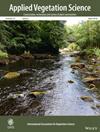Land Use Modulates Herbivory on Juvenile Stages of Woody Species in a Chaco Dry Forest
Abstract
Aims
Land use modifies natural forest herbivore assemblages by cattle introduction and structural alteration that impact invertebrate diversity. This land use and herbivory combined effect is particularly relevant for woody plant juveniles, which are key stages for regeneration. We aimed to understand how herbivory on juvenile woody plants is affected by land use. In this study, we analyzed how vertebrate and invertebrate herbivory patterns on seedlings and saplings change between land uses in winter and summer seasons.
Location
Southernmost Gran Chaco region, Córdoba province, central Argentina.
Methodology
We assessed the invertebrate and vertebrate herbivory on seedlings and saplings of woody species during summer and winter seasons at four different land use types of a Chaco dry forest. Land use types were classified according to the increasing intensity of disturbance (logging and grazing) they are subjected to: Conserved Forest (CF; no disturbance), Secondary Forest (SF; low disturbance), Closed Species-rich Shrubland (CS; intermediate disturbance), and Open Shrubland (OS; high disturbance).
Results
We found that total herbivory was consistently higher in SF and CS in both seasons. Vertebrate herbivory was higher than invertebrate herbivory in winter (except in CF), with the inverse pattern in summer. Differences between seedling and sapling stages were scarce, with not consistent patterns of herbivory between seasons.
Conclusions
This study shows a pronounced effect of land use on seasonal herbivory patterns and dynamics. The vegetation structure of communities under low and intermediate disturbance intensities would promote diversity of invertebrate herbivores, which, combined with cattle introduction, could result in herbivory complementation and additivity. Understanding how environmental filters, like anthropic activities and herbivory, interplay and affect early growth stages is crucial to achieving land use practices that do not compromise forest resilience and regeneration.


 求助内容:
求助内容: 应助结果提醒方式:
应助结果提醒方式:


